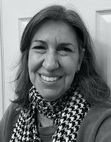Meredith Allard's Blog, page 30
October 26, 2015
An Interview With Circa Editor Jennifer Falkner
Jennifer Falkner is the creator and editor of the online literary journal Circa, which is devoted to historical fiction, which happens to be my favorite genre (for those of you who haven’t already guessed that about me). What makes Circa unique is the fact that Jennifer is from Canada, and she loves to publish stories about Canadian history. You can visit Jennifer online at her website.
I had known of Circa since it’s one of the few journals devoted to historical fiction (the other, of course, being some little journal called Copperfield something or other…). Copperfield has published a few pieces of Jennifer’s short historical fiction, so I knew she was a great writer as well as a great lover of historical fiction. Jennifer was nice enough to answer a few of my questions about historical fiction and Circa. Here are her responses. If you write short historical fiction, take note!
* * * * *
Meredith Allard: When and why did you begin writing, and did you always write historical fiction?
Jennifer Falkner: Writing stories is something I’ve just always done. I remember being nine or ten years old and writing westerns. I was going through a Louis L’Amour phase, I guess. But I only got serious about doing it well and for an audience besides myself after I turned thirty. I don’t always write historical fiction. If anything, I’d say half of what I write is contemporary. But the past has a fascination that I cannot ignore for long.
M.A.: What is your writing process like? When and where do you find time to write?
J.F.: Whenever I can. Sometimes that’s first thing in the morning before the rest of house is awake, sometimes squeezed in over lunch. Most often though I barricade myself in the study for three or four hours on Saturday and Sunday mornings.
M.A.: How would you describe your writing to potential readers?
J.F.: Improving, slowly.
M.A.: How did you come to start Circa, your online literary journal for historical fiction? Why did you choose to focus on historical fiction?
J.F.: There were so few venues dedicated solely to historical short stories when I started Circa a few years ago. There was The Copperfield Review, of course, and Alt Hist, Vintage Script, and Snapshots of History. Now, sadly, the latter two are no longer publishing. And none of them was in Canada. So it was partly out of self-interest; I wanted to read more historical fiction, especially stories to do with the Canadian past. And once I landed on the name, I couldn’t not do it.
M.A.: What would you like to tell those who love historical fiction and readers of Copperfield about Circa? How can they submit their historical fiction? How do you decide which pieces you’ll publish?
J.F.: To me, history is never bland. It’s lively, preposterous, funny, sad, bizarre, everything. I want Circa to reflect all of that.
With each issue, I feel Circa is getting stronger and more diverse. Pieces have to be well-written, obviously. The writer has to have done her work, researching, drafting, editing. I try to choose pieces from as many different periods as possible. This can be tricky because I receive a lot of submissions set during either the American Civil War or World War Two. And many submissions are not stories, but vignettes, a day in the life, which can be well done, but often read more like a history lesson. I want to be interested in the characters, I want to see them challenged and changed over the course of the story. And I love to be surprised.
Writers interested in submitting should check out Circa’s Submission page for instructions on how to submit.
M.A.: Which are your favorite historical novels? That’s often a tough call, I know.
J.F.: Oh, too many to list! But I’ll have a go. These are the books I read over and over. Orlando by Virginia Woolf; The Balkan Trilogy by Olivia Manning; Tristram Shandy by Laurence Sterne; anything by Hilary Mantel, of course, but especially her book The Giant, O’Brien, which will break your heart, it’s written so beautifully; The Passion by Jeanette Winterson. And I’m a sucker for whodunits set in Ancient Rome, especially the Falco series by Lindsay Davis and the Ruso series by Ruth Downie.
M.A.: Which authors are your inspiration—in your writing life and/or your personal life?
J.F.: Virginia Woolf, Jane Austen, Margaret Atwood, George Eliot, Fay Weldon, especially her Letters to Alice On First Reading Jane Austen – a must-read for any aspiring novelist and any Jane Austen fans, Jeanette Winterson, Elizabeth Gaskell. And probably a dozen others.
Hmm, I just noticed how many women are in my list.
M.A.: What advice do you have for those who want to write historical fiction?
J.F.: Read, read, read. Read in, around, and over the period in which your story is set. Then pick out the one or two details that make the period unique and bring it to life. The reader doesn’t want a history lesson.
M.A.: What else would you like readers to know?
J.F.: The next issue of Circa is due out October 15 and it’s bursting with great stories!
Filed under: Historical Fiction, Interviews Tagged: Circa, historical fiction, Jennifer Falkner, literary journals

October 14, 2015
Boo! It’s Time for the Spooktacular Giveaway Hop
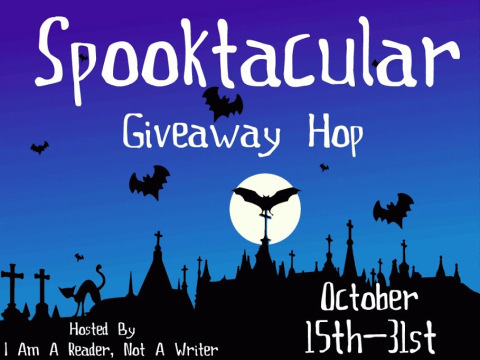
While I’m in writing mode, working on my new historical novel, and editing mode, putting the Copperfield Review‘s first anthology together, I thought it would be a great time to participate once again in the Spooktacular Giveaway Hop. If you’re not familiar with this hop, it’s one of the best events of the year for book lovers.
I love participating in this giveaway every year. After all, there’s no better time for the Loving Husband Trilogy–a vampire/witch/werewolf love story set during the Salem Witch Trials–than Halloween. There are more than 200 blogs participating, which means there are many wonderful prizes for book lovers to win. Check here for the list of participating blogs. Thanks to I Am a Reader, Not a Writer for hosting. This hop runs from October 15th to October 31st.
Two winners will receive a gift card (either BN.com or Amazon.com–your choice) for $10. Five other winners will receive a digital copy of the complete Loving Husband Trilogy (all three books) as either .mobi for Kindle, epub for Nook and iPad, or as a .pdf.
To enter, just fill out the simple form below. That’s it! There’s only one mandatory entry. All entry options can be found on the right sidebar of this page.
The winners will be announced on Monday, November 2, 2015 after 5 p.m. Pacific Time. Good luck!
[contact-form]
Filed under: Giveaways, Her Dear & Loving Husband, Her Loving Husband's Curse, Her Loving Husband's Return Tagged: Giveaways, I am a Reader Not a Writer, Spooktacular Giveaway Hop, The Loving Husband Trilogy

October 12, 2015
Spotlight: C.C. Humphreys and Shakespeare’s Rebel
Here’s a spotlight on author C.C. Humphreys’ new historical novel, Shakespeare’s Rebel. Check below for the link to the giveaway for a C.C. Humphreys book bundle.
* * * * *
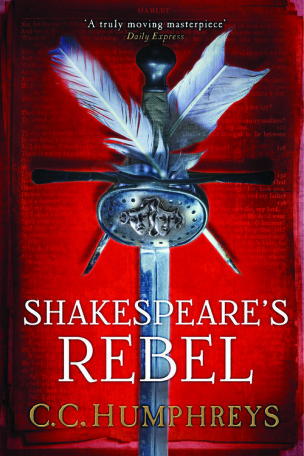 Title: Shakespeare’s Rebel
Title: Shakespeare’s Rebel
Author: C.C. Humphreys
ISBN: 9781492609902
Pubdate: October 6, 2015
Genre: Historical Fiction
Imprint: Sourcebooks Landmark
Summary
To be (or not to be) the man to save England
England’s finest swordsman and fight choreographer at the magnificent new Globe Theatre has hit rock bottom. John Lawley just wants to win back his beloved, become a decent father to his son, and help his friend William Shakespeare finish The Tragedy of Hamlet, the play that threatens to destroy him.
But all is not fair in love and war. Dogged by his three devils—whiskey, women, and Mad Robbie Deveraux—John is dragged by Queen Elizabeth herself into a dangerous game of politics, conspiracy, and rebellion. Will the hapless swordsman figure out how to save England before it’s too late?
Brimming with vivid periodic detail, Shakespearean drama, and irresistible wit, Shakespeare’s Rebel is a thrilling romp through the romantic, revolutionary times of Elizabethan England that will delight historical fiction fans and Shakespeare enthusiasts alike.
Exclusive excerpt
If John knew the odds of a street fight, he also knew its mind-set. There were always those uncommitted to its extremity. These could be swayed. Bribery had just failed to do so—yet swift ferocity might work. So he stepped away from his friend and the still bawling boy to give himself the room required.
It was a good plan, to take out the biggest threat and transform the rest into nervous bystanders. May have worked too—if John had not been betrayed by the unevenness of the stones underfoot, a misjudgment of distance, and the lingering effects of the heated double-double ale he’d just drunk.
He drew, screamed, “Heya!” and leaped. Tripped. Fell, his sword clattering onto the stones. Somehow he kept a grip upon it, which aided him not a jot, what with the apprentice’s boot upon it.
“Oh, John,” he heard his friend say. He squinted up at the butcher’s boy looking down.
“Now that,” the youth said, “was not very friendly, old man.”
He might have taken more offense if he were not lying with his ear pressed to shitrimmed cobbles and if the youth had not continued, to the crowd, “You all witnessed who drew first. So I’m going to let him rise—and then give him a little lesson in swordplay.”
The boot withdrew. John rolled clumsily away, got onto knees, thence onto shaky legs. The butcher’s boy stepped back, handed his cleaver to a friend, then reached to his side and began to draw, very slowly, a rapier from its scabbard. The weapon’s speed was partly dictated by its length—at least a foot longer than the limit decreed by Her Majesty. Once clear, he also withdrew a long dagger, raised both weapons into the air, to another huge cheer, the onlookers so thrilled by this escalation that not one yelled out when the accused thief, cause of the quarrel, slipped from Shakespeare’s neck and sprinted off down the alley.
Escalation…escalated. Where two swords were bared, suddenly there were nine, for the six other apprentices also now had their rapiers out. As Will drew his, John stared. “Is there not an ordinance, Will,” he mumbled, “that decrees only gentlemen may carry rapiers?”
The butcher’s boy overheard—and smiled. “’Tis true indeed, sir, which is why we carries ’em.” He turned and grinned at his companions. “’Cos we is all fucking gentlemen.”
More cheers at that. They were spreading into a halfcircle when, from behind them, flagons appeared, borne by drudges from the tavern, the landlord following, a large man who shouted as he came, “A sixpence says it is over in less than a minute. I offer odds of three to one!”
“I’ll take sixes,” a man cried out. “These are real gentlemen, after all.”
_________________________________________________________________________________

David Cooper Photography
2007
Chris (C.C.) Humphreys is an actor, playwright, fight choreographer and novelist. He has written nine historical fiction novels including The French Executioner, runner up for the CWA Steel Dagger for Thrillers; Vlad – The Last Confession, the epic novel of the real Dracula; and A Place Called Armageddon. His latest YA novel is The Hunt of the Unicorn. His work has been translated into thirteen languages. Find out more about him on his website: http://cchumphreys.com.
Facebook: https://www.facebook.com/authorcchumphreys
Twitter: https://twitter.com/humphreyscc
Goodreads: http://www.goodreads.com/author/show/80075.C_C_Humphreys
Buy Links
Amazon: http://www.amazon.com/Shakespeares-Rebel-Novel-C-C-Humphreys/dp/1492609900
Barnes & Noble: http://www.barnesandnoble.com/w/shakespeares-rebel-cc-humphreys/1113921022
Indie Bound: http://www.indiebound.org/book/9781492609902
Giveaway
Click here for a chance to win a C.C. Humphreys book bundle.
Filed under: Giveaways, Guest Authors Tagged: C.C. Humphrey, Giveaways, guest authors, Shakespeare's Rebel

October 2, 2015
Charlie Britten at The Anne of Green Gables Museum
* * * * *
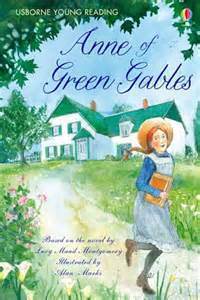
My eyes brimmed with tears, one of those moments so intense I wanted to make it end, to run out into the safety of the hire car, the road and the twenty-first century. Yes, I know it was all fiction and none of it really happened, but L M Montgomery’s Anne Shirley figured as large in my childhood as the flesh-and-blood friends I met in school every day. And here I was, in this beautiful house, fitted out with its simple and functional furniture, but with lace everywhere – over the mantelpiece, over the tables, in the bedspreads, exactly as it would’ve been in her time. Anne was here, and Gilbert, and Marilla, and Rachel Lynde, and all the others. I’d travelled over three thousand miles for this and probably would never return. I took a deep breath and carried on.
The Anne of Green Gables Museum is at Park Corner, on the north coast of Prince Edward Island, at a Gothic Revival farmhouse called Silver Bush, the former home of author Montgomery’s Uncle John and Auntie Annie Campbell. The first Campbells settled in this house in 1776 and the family lives here still, managing the Museum, which appears on Canada’s Historic Places Register and Prince Edward Island’s Register also. Although the real Lake of Shining Waters is just down the hill from the main museum building, this is not Green Gables, but Silver Bush, as featured in two of Montgomery’s other books, Pat of Silver Bush and Mistress Pat. It was in this house, which she called the wonder castle of my childhood, that Montgomery felt comfortable, not in the official ‘home of Lucy Maud Montgomery’ in the village of Cavendish a few miles away, which is advertised in tourist literature.
The Museum has two storeys. You enter (like Mrs Rachel Lynde in the first pages of Anne) through the kitchen, passing the leaded range to pay at the desk (in summer 2015, $5.50 for adults and $2 for children). You move through into the lacy Edwardian parlour, where a clock ticks loudly and lugubriously and you see the small organ which was played at Montgomery’s wedding in 1911 to Presbyterian minister, Ewan Macdonald. You think about small children, sitting still on hard chairs, in their best clothes – hopefully with puffed sleeves – longing for Sunday to end. A letter in the parlour, written a year before the author’s death in 1942, thanks her nephew for sending $10, because, she tells him, she doesn’t have enough money for the nursing care she needs, even though by this time, Anne of Green Gables was enjoying huge popularity and Montgomery would have been earning from her many other books.
Upstairs are a family bedroom, a child or single person’s room and a hallway, where first editions of Montgomery’s books are on display – not just the Anne books, but a selection of her twenty-two novels, and the short stories she used to submit to magazines in the days before Anne. You may touch these faded volumes, even read a little. Hanging on the wall is the crazy quilt Montgomery stitched as a teenager, using any scraps of fabric she could find, and which she finished only after the fashion for crazy quilts had passed, but, as she wrote in her diary, she had had the ‘joy of making’ [1] – a typically upbeat and stoical comment. Born in Clifton (now New London) in PEI in 1874, Montgomery’s mother, Clara, died of tuberculosis when the author was twenty-two months old. Mounted on the same wall is a journal entry, in which the author relates how, as an adult, she encountered a friend of her mother’s, who tells her how Clara entreated her to come and see her baby because ‘little Lucy Maud is so sweet today’. This is what brought me to tears in the warm yellow afternoon sunshine.
There is a danger that the whole of Prince Edward Island will be subsumed by the commercial opportunities offered up through Anne of Green Gables and her creator. Everywhere you can buy red-haired Anne dolls, stay at several different Green Gables motels, eat at Green Gables cafes, bathe on the Green Gables Shore (the Island’s north facing beach), and, in the Homburg Theatre in the Island’s capital, Charlottetown, see Anne of Green Gables: The Musical, which has been running continuously since 1965.
I’m glad I went to the Museum first, when I had been on the Island only a few hours, because it captured the spirit of Montgomery’s stories, which were about people living a simple life in farming communities at the beginning of the twentieth century, their underpinning stoicism and joy in small things. Montgomery loved to visit Silver Bush because here she was loved and that loving feeling lingers on. The last words in Anne of Green Gables, were a quote from Pippa Passes, Browning’s long narrative poem (1841) – significantly – about an orphan. “God’s in his heaven, all’s right with the world!” whispered Anne softly.”
For more information about the Anne of Green Gables Museum, visit http://www.annemuseum.com.
http://www.gov.pe.ca/firsthand/index.php3?number=43770&lang (From The Selected Journals of L. M. Montgomery, Volume II, 5)
Filed under: Guest Authors Tagged: Anne of Green Gables, Charlie Britten, guest authors, Prince Edward Island, The Anne of Green Gables Museum

September 21, 2015
Spotlight: Elizabeth Chadwick and The Winter Crown
Elizabeth Chadwick, one of my favorite historical fiction authors, has a new novel–The Winter Crown. Here’s a spotlight on her second book about Eleanor of Aquitaine. Enter the Rafflecopter Giveaway below to win a copy of Chadwick’s first novel in the Eleanor of Aquitaine trilogy, The Summer Queen.
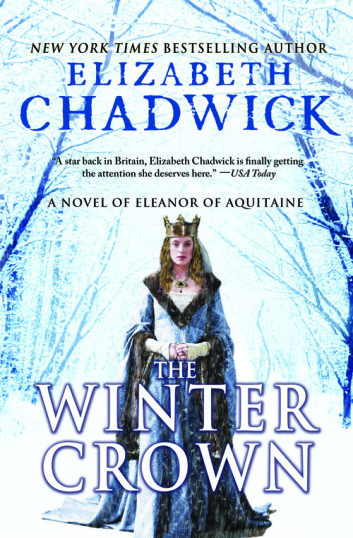 Summary
Summary
As Queen of England, Eleanor has a new cast of enemies—including the king.
Eleanor has more than fulfilled her duty as Queen of England—she has given her husband, Henry II, heirs to the throne and has proven herself as a mother and ruler. But Eleanor needs more than to be a bearer of children and a deputy; she needs command of the throne. As her children grow older, and her relationship with Henry suffers from scandal and infidelity, Eleanor realizes the power she seeks won’t be given willingly. She must take it for herself. But even a queen must face the consequences of treason…
In this long-anticipated second novel in the Eleanor of Aquitaine trilogy, bestselling author Elizabeth Chadwick evokes a royal marriage where love and hatred are intertwined, and the battle over power is fought not with swords, but deception.
Here Are Three Little-Known Facts about Eleanor of Aquitaine, One of the Most Powerful and Influential Women of the Middle Ages:
By Elizabeth Chadwick
She got married when she was 13 and became Queen of France at that age too. Her husband, Louis, was 17, and they met only a week before their wedding. For a long time, historians thought she was 15, and you will still see some of them write it that way. But new research favors the age 13—and what a difference that makes to me as an author coming at it from that perspective. It provides a whole new take on the story.
Eleanor gave her husband Louis a vase for a wedding present that still exists today. It was made of carved rock crystal and was already hundreds of years old when she gave it to him. Her grandfather had brought it back with him from the Crusades. When she gave the gift to Louis, it was a plain, unembellished object, except for its detailed honeycomb carving. Later on, Louis gave it as a gift to his tutor, Abbe Suger, for the treasury of St. Denis. Suger then had it decorated with gold and precious gems, completely changing its original, more subtle appearance. You can still see the magnificent “Eleanor vase” in the Louvre Museum in Paris.
No one knows what Eleanor looked like. There is not a single proven description of her anywhere in any medium. She is variously described by her biographers as a brunette, a blond, and a redhead, but the truth is we don’t know.
Social Network Links
Twitter: https://twitter.com/chadwickauthor
Goodreads: http://www.goodreads.com/author/show/25765.Elizabeth_Chadwick
Buy Links
Amazon: http://amzn.to/1Ob5enk
Barnes & Noble: http://bit.ly/1KOOAJu
Indie Bound: http://bit.ly/1MndO1W
Books A Million: http://bit.ly/1iJV400
Book Information
Title: The Winter Crown
Author: Elizabeth Chadwick
ISBN: 9781402296819
Pubdate: September 1, 2015
Imprint: Sourcebooks Landmark
Genre: Historical Fiction
Here’s the link for the Rafflecopter Giveaway of Chadwick’s first novel in the Eleanor of Aquitaine trilogy, The Summer Queen.
_________________________________________________________________________________
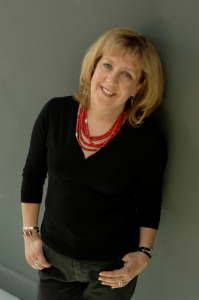
Elizabeth Chadwick photographed by Charlie Hopkinson. © 2007
“A star back in Britain, Elizabeth Chadwick is finally getting the attention she deserves here,”—USA Today.
Chadwick is the bestselling author of over 20 historical novels, including The Greatest Knight, The Scarlet Lion, A Place Beyond Courage, Lords of the White Castle, Shadows and Strongholds, The Winter Mantle, and The Falcons of Montabard, four of which have been shortlisted for the Romantic Novelists’ Awards.
Filed under: Giveaways, Guest Authors, Historical Fiction Tagged: Eleanor of Aquitaine, Elizabeth Chadwick, Giveaways, guest authors, The Summer Queen, The Winter Crown

September 8, 2015
The Audio Trilogy is Complete, and a Giveaway!
I hope everyone has been well these last few weeks of summer. Yesterday in the U.S. we celebrated Labor Day, which is the official mark of the end of summer, though you’d never know it from the 100+ degree weather we’re expecting in Las Vegas this week. As the seasons have been changing, I’ve been making some changes myself, good changes, I think–changes that will allow me more time to focus on what’s really important to me. I’ve left behind teaching full time to focus on my PhD studies, which are time consuming in themselves, but which will also allow me the freedom to focus on The Copperfield Review and Copperfield‘s first anthology, which is coming out in October. I’ve had a feeling for some time that Copperfield could go even farther than it already has, and now I have the time to make that happen. I’ll also have more time for my own writing, and I may actually finish my new novel and the prequel to the Loving Husband Trilogy, “Down Salem Way,” before the year is over.

Her Loving Husband’s Return is now available on audiobook.
I’m pleased to announce that the third book in the Loving Husband Trilogy is finally available as an audiobook from Amazon, Audible Audiobooks, and iTunes. For those of you who have the first two audiobooks, you know it took a little time to complete the trilogy. The first two books have been available for over a year, but Laura Jennings, the narrator, was busy, and I was too busy to try to find someone else. I tried to do it myself, but that didn’t work out as well as I has hoped. Then a few months ago Laura reached out and said she was available once again, and I was thrilled. Laura narrated the first two books, and I was so happy she would be able to do the third as well. I absolutely love the storyteller tone in her voice. I think I would listen to anything she read. Laura has the kind of voice that will pull you into any story any time any place. I’m very lucky that she was able to do all three books.
Thanks to Audible.com I have 5 copies of Her Loving Husband’s Return to give away. Yes, it’s the third book in the trilogy, but I think the story stands pretty well on its own, and there’s enough back story to help you along the way. Just fill out the quick form below (name and e-mail address are all you need) and on Friday, September 18, 5 random winners will be chosen. Good luck!
[contact-form]
Filed under: Giveaways, Her Loving Husband's Return, News Tagged: audiobooks, Giveaways, Her Loving Husband's Return, The Loving Husband Trilogy

August 14, 2015
Guest Post: Exploring the Koestler Suicides
Here’s a guest post from Bernard Otterman where he discusses his experiences writing historical fiction set in the dim, dear past of the 1980s.
* * * * *
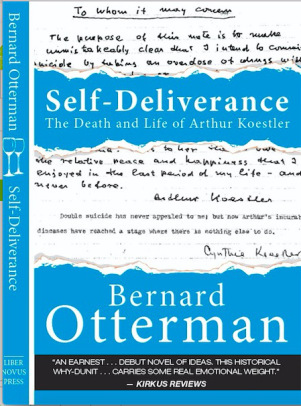 For a long time I wanted to write a novel at whose center would be a love story. I wasn’t thinking about a Harlequin romance or a tear jerker like Eric Segal’s novel, but a mature story, which would among other virtues, shed light on my own love story which includes a marriage which has lasted forty six years.
For a long time I wanted to write a novel at whose center would be a love story. I wasn’t thinking about a Harlequin romance or a tear jerker like Eric Segal’s novel, but a mature story, which would among other virtues, shed light on my own love story which includes a marriage which has lasted forty six years.
While seeking a frame for such novel, I read a biography of Arthur Koestler, who committed suicide together with his much younger wife in March 1983. At the time of his death, Arthur Koestler was as well known in London as Jean-Paul Sartre was in Paris. Darkness at Noon is judged by many to be one of the most important books of the twentieth century. He had also penned The God That Failed, a memoir of Communist faith and disillusionment. Critics claimed that Spanish Testament, his autobiography about his experience fighting in the Spanish Civil War and his imprisonment there, ranked with the war reportage of George Orwell. Later in his life, shortly before becoming prime minister, Margaret Thatcher requested that Koestler pay her a visit.
It is not known if this meeting ever occurred, but what is known is that the morning of the third of March, 1983, the bodies of Arthur and his wife, Cynthia were discovered by the police at their house located in the Kensington section of London. Arthur slouched in his living room chair dead, his wife – twenty five years younger — lying on the adjacent sofa also dead. The initial police report suggested a double suicide. My and many other people’s reaction was one of horror.
Arthur’s decision at the age of 78, terminally ill, is understandable. But why would a healthy and good looking woman of fifty-three also decide to kill herself? Did she act on her own volition or was she forced or tricked to end her life? For me, a child Holocaust survivor, life is precious. Even in death camps such as Auschwitz, very few inmates “took to the fence” — committed suicide by impaling themselves on the electric fence. Classical literature such as Romeo and Juliet and Tolstoy’s Anna Karenina, as well as occasional real life reports, suggests that love, when taken to the extreme, can make a partner or a spouse choose death over living the “practical life” without the beloved.
The Koestler’s suicides present an opportunity to examine love by forming a fictional group tasked to investigate the mystery of their deaths. Moreover, by subjecting the members of this group to their individual love troubles, I was able to study love in a wide variety of situations, such as cheating in marriage, love between individuals from different cultures, and expectations of what love can or should create in a good marriage, namely, a good life.
* * * * *
 Bernard Otterman is the author of Self-Deliverance: The Death and Life of Arthur Koestler. You can find out more about Bernard and his book at bernardotterman.com. The book is available on Amazon and Barnes and Noble.
Bernard Otterman is the author of Self-Deliverance: The Death and Life of Arthur Koestler. You can find out more about Bernard and his book at bernardotterman.com. The book is available on Amazon and Barnes and Noble.
Filed under: Guest Authors, Historical Fiction Tagged: Bernard Otterman, guest posts, historical fiction, Self-Deliverance: The Death and Life of Arthur Koestler

August 7, 2015
Writing Tools: Scrivener, I Love You
A few weeks ago I wrote about how I had been struggling as I was writing my new historical novel. Nothing in the story seemed to be working, and for whatever reason I was at a loss as to how to fix it. In this post I talked about how I decided to give myself some time off from writing. It was the best decision I could have made since it allowed me to take the brain break I desperately needed. I’ve been writing long enough to know that the ideas would show up when they were ready, and I was right. Only this time I had some help from an unexpected source.
About two years ago I bought Scrivener as a screenwriting tool. I used it to write a couple of screenplays, and that was that. I saw that it could be used to write novels, but when I looked at the directions they didn’t make sense and at that time I didn’t have the patience to fiddle with it. For whatever reason I found the directions confusing and the buttons and other tchotchkes didn’t make sense. I ended up leaving the program to languish unused and hidden in my Applications folder. While I was taking a break from writing my novel, I kept reading these posts about Scrivener and how all these writers said the program changed their writing for the better. Kristen @ She’s Novel pins these Scrivener Tutorial Posts on Pinterest, and Joanna Penn from The Creative Penn offers a course about how to use Scrivener. As I read these articles, I remembered that I had Scrivener on my computer. I wasn’t sure if the program could help me through the fog that was my novel, but I figured it couldn’t hurt to try.
Before I go on, I should point out that I’m not getting any compensation from the nice Scrivener folks at Literature and Latte for this. I’m simply sharing why I’ve come to love the program and how it helped me write my novel after I had been stuck in the mud for some months.
When I decided to try Scrivener for novel writing, I looked at the directions again, and again they didn’t make sense. This time, though, I was motivated to keep trying, and I watched some of the Scrivener tutorials on YouTube. The tutorials were integral in helping me understand what the buttons and tchotchkes were for and how they were used. My suggestion is to not try Scrivener without first watching a few of the videos or taking an online class. Where most computer programs can be figured out by twiddling with them, I find Scrivener needs further explanation. It seems confusing at first, but after I watched a few videos and played around with it I found it rather easy to use.
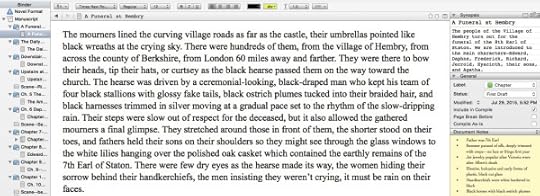
I’m not going into step-by-step details about how to use Scrivener since there are so many tutorials that do that far better than I can. I’d just like to point out some of the features that helped me get my thoughts straight. First of all, I like that you don’t have to write your novel in one long file. You can write your story in separate chapters or you can write your story in scenes if that’s the way you think. You’ll notice on the left-hand side of the screen the different folders for each section I have so far. On the same screen you can also see your synopsis of the section you’re writing, and you’ll notice I added my research notes in the bottom right hand corner. This way I don’t have to go back and forth between my research notes and the section I’m writing—the notes are right there on the screen. If you find those doo-dads on the screen too distracting, you can use the full screen mode so all you see is the text you’re writing.
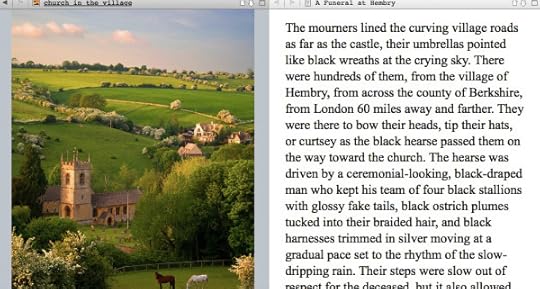
Now here’s something I really love about Scrivener—the fact that you can import photos. The novel I’m writing is historical fiction, set in England in 1870, and so of course I need references about clothing, buildings, gardens, furniture, etc. If I want to see a particular photo, all I need to do is scroll down to the folder where I store my photos, click on the one I want, and there it is. If I split the Scrivener screen (another handy-dandy function) I can have the photo right in front of me as I describe it. In the example you can see the photo of the church in the beautiful English countryside, which is the photo I used as inspiration for the funeral scene that happens at the beginning of the story. With the split screen I can look right at the photo while I’m writing. Since I tend to use photos to inspire my writing, this feature alone makes Scrivener a winner for me.
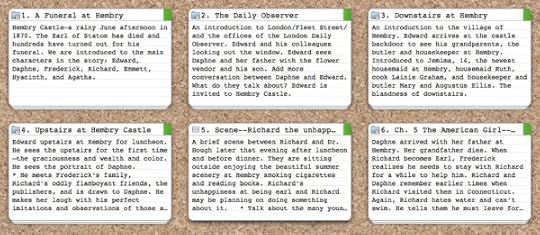
Another thing I love is the corkboard. I know a lot of writers who use have real corkboards on their walls in their writing space. They write scenes, ideas, notes, etc., on index cards and pin the cards onto the corkboards. I’ve always loved that idea, but I don’t have enough room on my walls for a corkboard so I was never able to try it out. With Scrivener’s virtual corkboard I don’t need room on my walls. I can create virtual index cards with all of the same details—characters, plot, research, ideas, notes—and I can rearrange the cards however I like. This feature actually helped me figure out the plot because I could see at a glance that the order of some of the scenes didn’t quite fly and I kept rearranging the cards until I liked the way the scenes flowed. I was also able to spot that there was some missing information—missing scenes, if you will—and I was able to add new cards with information about what will happen in that scene.
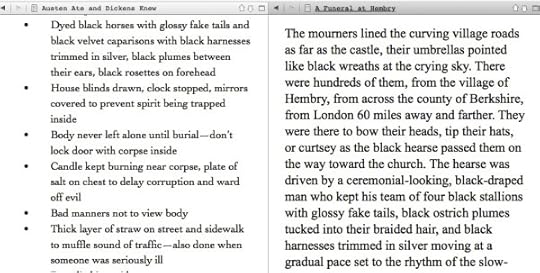
I also like the fact that I can add my research notes. Since my novel is historical fiction, I have pages and pages of research notes that I need access to while I’m writing. Instead of keeping a messy pile of notebooks around, which is the way I used to do it, I typed my notes into the Research section of Scrivener. From now on, instead of handwriting my notes I’ll type them into Scrivener. If you’ve typed your notes on another program like Word, Scrivener allows you to import them so you don’t have to retype them. And just like with the photographs, you can split the screen and look at your notes while you’re writing. As I said earlier, I like to add my research notes to the bottom right hand corner of the page, but if I have a lot of research notes for a particular section, I’ll probably split the screen so I have easy access to all the information.
Through the process of adding my novel to Scrivener, deciding on the folders I needed, using the corkboard, and importing the photographs and research notes, I was able to sort through the story. As a result, a lot of the problems I had are gone. I understand the characters better, I have a plot I’m happy with, and I can see where the story is going and what the underlying themes are. What Scrivener did for me was allow me to think through the story in a step-by-step way that helped me see what was missing and what needed to be reorganized and revised. I still have a lot of work ahead of me, but at least now I have a direction, which I didn’t have before.
I’m definitely on the Scrivener bandwagon. It isn’t crazy expensive ($44 when I bought it), and to me it’s worth the price for the way it allows me to organize my work. They even offer a free 30 day trial so you can try it out to see if you like it.
Have you used Scrivener? If so, what has been your experience? If not, are you going to try it?
Filed under: Historical Fiction, Writing Tagged: Scrivener, writing, writing a novel using Scrivener, writing tips, writing tools

July 14, 2015
Guest Post: Writing the Love that Dare Not Speak Its Name in Historical Fiction
* * * * *
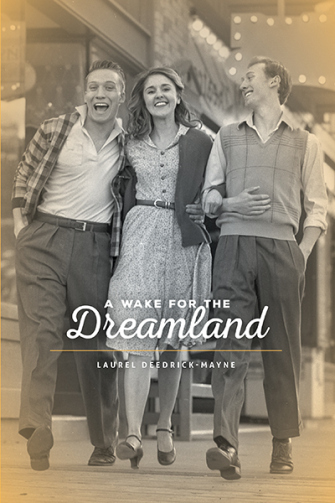 How do we write the love that ‘dare not speak its name’ within the genre of historical fiction? I confess that even writing the love that can be ‘shouted from the rooftops’ has thrown me into flushed-faced fits of laughter… and since this is historical and not hysterical fiction, I have to take a deep breath; maybe recline amidst the mass of rumpled sheets…not those kinds of sheets… (picture me tearing page after page of bad sex writing out of an old underwood) and try, try again. It’s not all ripping corsets and popping buttons.
How do we write the love that ‘dare not speak its name’ within the genre of historical fiction? I confess that even writing the love that can be ‘shouted from the rooftops’ has thrown me into flushed-faced fits of laughter… and since this is historical and not hysterical fiction, I have to take a deep breath; maybe recline amidst the mass of rumpled sheets…not those kinds of sheets… (picture me tearing page after page of bad sex writing out of an old underwood) and try, try again. It’s not all ripping corsets and popping buttons.Writing historical fiction is tricky to begin with— dodging the deadly slings and arrows of ridiculously overly researched, smarty-pants narrative history dumps, often at the expense of our beloved characters. Trickier still: How does a middle-aged-heterosexual woman in 2015 write about sexual awakening of a male soldier in WWII? One can’t even fall back on cliché because…back to my opening sentence: it was love unspoken and unwritten. Homosexuality was a criminal offence under civil law and convicted service personnel risked court martial and dishonorable discharge. See what I mean? There was an accidental history dump.
In my book, A Wake For The Dreamland, the world is on the brink of war and friends William, Robert and Annie are on the cusp of adulthood. Haunted by memories of a boyhood dalliance with a lad and more than platonic feelings for Robert, William feels shame and longing to be ‘normal’. But these are not normal times. Every arena of their young lives is infiltrated by the war, from the home front to the underground of queer London to the battlefields of Italy.
The moment I knew I was writing a love triangle, I also knew that William would be gay. It seems strange to say this but I knew he was gay before he did. That is to say, I understood that the emotional stakes were very high and that it was up to me, to write his experience in the most authentic and honourable way possible. When I began writing in 2003 there was scant information available on homosexuality in WWII. But there were a couple new documentary films and a few excellent books. I had the benefit of a thoughtful archivist who remembered cataloguing a collection of love letters between two men from the 1940’s. And then, there was mustering the courage to come right out and ask the veterans who were helping me with the military aspect of my research. It wasn’t always easy and I experienced some kick-back along the way. There was the retired Major who, upon listening to my ‘Reader’s Digest Condensed’ version of the novel, declared, “Not in this Regiment!” That nearly sent me scurrying into re-write mode but another veteran friend, 90 years old at the time, reassured me that of course there were gay men in the unit. It didn’t bother anyone so long as they were a good soldier and did their job. I guess if you’re a good killer it doesn’t matter what kind of lover you are. There was the indignant participant at a workshop where I read an excerpt. She demanded to know, “Does your veteran friend know you’ve turned him into a homosexual?” I admit I had some fun with that one.
Where the truth lies, is the no man’s land where historical fiction writers tread. Writing the love that dare not speak its name during WWII and the aftermath was like crossing a minefield that could end in disaster. Confinement to a particular time and place in history: truth; gave me a scaffold upon which my imaginary friends could play out their infinite and intimate struggles and triumphs: lies. It was the ‘story’ in history that mattered to me. Nothing else. I kept reminding myself not to be afraid to be afraid, that this was not a story about war as much as it was a story about love. Those rushes of adrenalin were there to remind me I was on the right track.
Those of us writing historical fiction are excused from that old prescriptive chestnut: write what you know. But if we know something about friendship and love, fear and longing, grief and loss— that understanding will allow our characters to rise from the page and into the very hearts of our readers. The rest, as they say, is history. And my closing advice to anyone is simply this: Soldier on.
* * * * *
Excerpt from A Wake For The Dreamland
It was London where he felt most alive. Where he could walk the line between civilian and serviceman, where he could connect with other Allied soldiers for whom the city held the same degree of safety and danger, possibility and peril, sociability and sex. At the Buckingham Gate Urinal or alongside the Albert Tavern, behind two telephone booths, he could steal a kiss or more…gratify his longing. There, or Charing Cross Station, or the gardens in Trafalgar Square.
But it was at Cyril and Lou’s apartment, in an enclave of others like himself, that he first slept in the arms of a man, a lover. There, for three days and nights, the sport he endured and enjoyed came as close to killing him as the war ever would— and it was heaven. Spending each waking moment in the pursuit, the act, or recovery from every conceivable means of lovemaking. To sleep: however briefly, only to be awakened by hunger in the belly, mouth, or groin. And listening: to music, to poetry – reading and writing it, too— and eating and drinking and tumbling, tumbling willy-nilly into bed again.
In the city her learned the language of his type: invisible to passersby, visibly to each other. He learned to go from being hunted to being the hunter. He learned to find his way in the dark, to seek an encounter, to be less afraid, less alone, seduced by the allure of safety and privacy where he could be himself without fear of discovery. And yet. While the other fellows were sleeping it off and the mantle clock in the parlour squeezed out the minutes until dawn, a sickening sadness would sneak through his limbs and curl up in a ball at the foot of his heart.
_________________________________________________________________________________
 Laurel Deedrick-Mayne was born and raised in Lacombe, Alberta but has spent her adult life as a city dweller and now makes Edmonton her home. Once an arts administrator (dance publicist, concert promoter and ad copywriter) Laurel has become a juggler: raising a family, managing her private massage therapy practice, serving on multiple arts boards … and writing. This book is a tribute to the generation of her parents, grandparents, aunts, and uncles who took the time to hang on to family letters, clippings, stories, and poetry — all those treasures that inspired this story. A Wake For The Dreamland is Laurel’s first novel.
Laurel Deedrick-Mayne was born and raised in Lacombe, Alberta but has spent her adult life as a city dweller and now makes Edmonton her home. Once an arts administrator (dance publicist, concert promoter and ad copywriter) Laurel has become a juggler: raising a family, managing her private massage therapy practice, serving on multiple arts boards … and writing. This book is a tribute to the generation of her parents, grandparents, aunts, and uncles who took the time to hang on to family letters, clippings, stories, and poetry — all those treasures that inspired this story. A Wake For The Dreamland is Laurel’s first novel.
Filed under: Guest Authors, Historical Fiction, Writing Tagged: A Wake for the Dreamland, guest authors, guest blogs, historical fiction, Laurel Deedrick-Mayne, World War II, writing historical fiction

July 8, 2015
Dare To Do Nothing: Replenishing the Creative Well

The view from the park in The Lakes in Las Vegas.
To say I had been having a busy time of it would be an understatement. Suddenly, I was a university student for the first time in 20 years, I was still a full time teacher, and I was working on the first draft of my new historical novel. I was looking forward to summer vacation from both work and school as a time to focus on my novel full time. I think this is why I’ve never been worried about having a day job—even with my day job I still get summers off to write full time. Then a funny thing happened—nothing.
The novel was stalled. Where my last three novels were written fairly quickly in less than a year (that’s quickly for me, mind you), my current novel was stubborn and not coming as easily as I would have liked. I didn’t understand the characters as well as I thought I did. I felt the plot was lacking, though I couldn’t tell you why. I wondered and worried myself crazy, and while I tried to work on the book I realized I was getting nowhere fast. That’s when I came up with the radical idea of putting my writing aside for a while and leaving it alone. Normally, I allow the story some baking time after the first draft, which I had done, but then when I went to write the second draft there wasn’t much more than there had been for the first draft. The second draft is a little better than the first, but it’s nothing to write home about, and it’s definitely not publishable. For my last three novels, once I made it past the “shitty first draft” stage and had a complete second draft I was, except for revising and editing, home free. This one not so much. I was getting so frustrated I was ready to throw in the towel and forget the novel altogether.
I hadn’t suffered from writer’s block in this form since I first began writing Her Dear & Loving Husband in 2009. What if I never have another good idea? What if being a doc student has sucked away all my brain power and I simply can’t write fiction until I’m finished with my degree? What if this is it and my creativity is gone, finished, kaput? You know how writers panic when the ideas aren’t flowing. Then I started thinking about how I’ve been writing novels constantly for the last six years without a break. Since 2009, I’ve published seven novels. And the scholarly writing I do for school is creative in its own way since it takes creativity to figure out how to take information from various sources and construct a well-organized, persuasive narrative. Maybe, I thought, just maybe my creativity isn’t kaput as much as just tired.
I’ve suffered, like many of you, from what they call the Do Something Syndrome at Farnam Street blog. Even on my days off I feel like I have to constantly be working at something—whether it’s writing, editing, schoolwork, marketing, social media, whatever. I started reading a lot about stillness and how doing nothing can help to fill your creative well. Here’s a great post from one of my favorite websites, Zen Habits, called The Number 1 Habit of Highly Creative People where the artists talk about stillness and doing nothing as a way to stay creative. There are a number of other articles out there on the same topic. Doing nothing? I wasn’t sure I could do that, but I was willing to try since my creative well definitely needed replenishing. This hiatus was going to be different from the baking time since baking time is where, though I’m not actively writing, I’m still working on the novel because I’m reading, researching, and finding other ways to immerse myself in the story. This time I was going to leave the story completely alone and give myself a rest from even thinking about the novel.
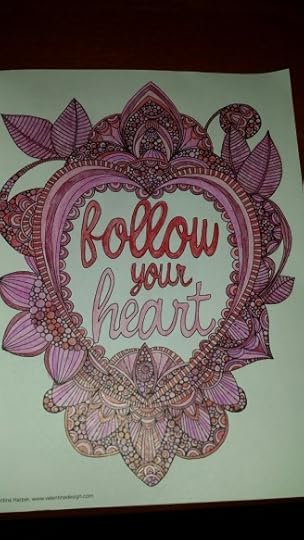
A page from my coloring book. I like this book, called Creative Coloring Inspirations, because of the inspirational quotes.
How have I been spending my days? Well, I haven’t been working on the novel, which is how I thought I would be spending this summer. I haven’t even felt guilty about not working on it—most of the time. Writers are great at laying the guilt trip on themselves, aren’t they? Whenever I see a book I’ve read for research laying around my desk, I remind myself that I’m filling my creative well and look the other way. Instead, I’ve been sitting on my little patio with my cat Ellie as we watch the Las Vegas desert sky turn from pale blue to slate gray as the thunder-filled clouds move in. I’ve gone to the park down the street with its fake lake (the water is real even if the lake is man made) and looked at the ducks, the boats, the pretty houses, and the mountains in the distance. I’ve been exercising and doing yoga after a bout of laziness. I’ve discovered the charms of adult colorng books (they’re just regular coloring books with more intricate details, folks. I know what you were thinking…). I used to love to color when I was a kid, and it turns out I still do. I’ve always considered myself a wannabe artsty-craftsy kind of person. I love watching the how-to-paint-flowers shows they have on PBS, and I even dabbled in painting with acrylics a few years ago. While coloring isn’t exactly an original piece of art, I enjoy the chance to play with colors and I’ve rediscovered the fun of crayons, colored pencils, and watercolors. I’ve been reading a lot, finishing two or three books a week. I’ve been watching some good TV shows, movies, and documentaries (yes, I watch documentaries for fun). Saying that I’ve been doing nothing isn’t quite accurate, but I haven’t been writing fiction, thinking about writing fiction, or, most importantly, worrying about writing ficiton. I’ve just been enjoying my days and filling them however I want to rather than stressing myself out about what I thought I should be doing.
Then, a couple of months into my self-imposed exile from writing fiction, I read a couple of novels that gave me some ideas for my own story. I still have things to figure out, but at least I have a few ideas now where before I had nothing. I refuse to start worrying again about when or how the book will be written. If it takes me two years instead of one to write, then so be it. I’d rather spend two years writing the story I meant to write than publish whatever just to get something out. Everything happens in its own time. I’ve always known that, but I find I need a reminder every now and again.
Filed under: Spirituality, Writing Tagged: creativity, spirituality, stillness, writing


